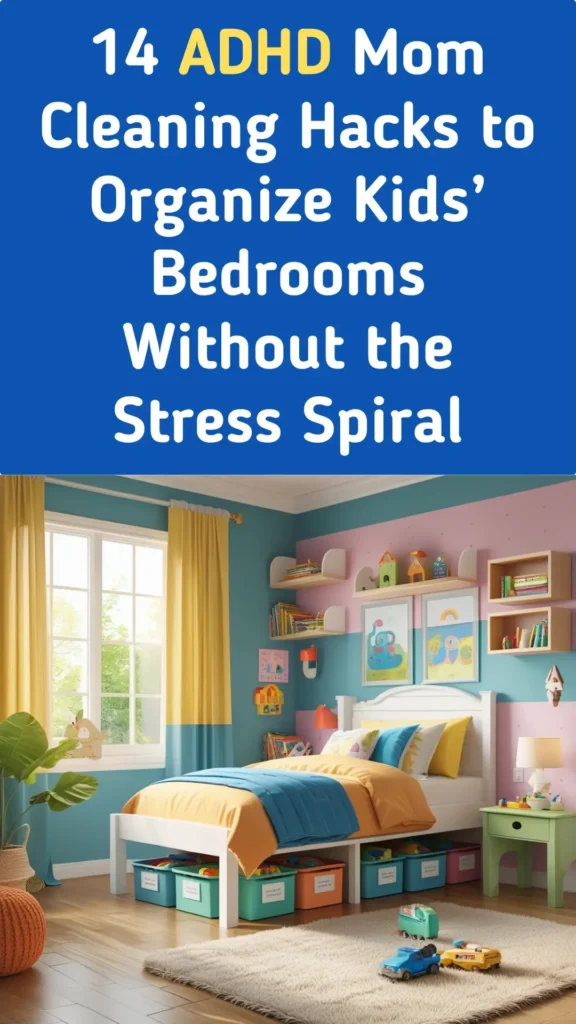If the thought of cleaning your kid’s room makes you want to hide under a blanket, you’re not alone.
I’ve been there. Standing in the doorway, staring at what looks like a toy store explosion, wondering how it got this bad again.
Then I do what so many ADHD moms do: close the door and walk away, because the overwhelm feels bigger than the mess itself.
But here’s what I’ve learned: it doesn’t have to be this hard.
These are the real-world hacks I use when my ADHD brain hits its breaking point. When I can’t handle one more meltdown or clutter avalanche.
Whether your child has ADHD or not, these strategies truly work. In both situations, they make a noticeable difference.
📌 Don’t forget to save this pin for later!

Let’s start small and win big.
1. Start ridiculously tiny (like “5 things” tiny)
When the whole room feels impossible, don’t tackle the whole room.
Just pick up five things. Five toys. Five pieces of trash. That’s it.
This simple trick pulls your brain out of panic mode.
And sometimes (not always, but sometimes) momentum kicks in once you get started.
2. Use the “Five Things Tidying Method”
It sounds almost too simple, but it works.
Look around and sort everything into just five categories:
- Trash
- Laundry
- Things that stay in the room
- Things that belong somewhere else
- Things that don’t have a home yet
No overthinking. Just touch and toss into the right pile.
3. Stop relying on your memory (externalize everything)
Slap sticky notes right on the wall.
Use picture labels on bins instead of words.
Our ADHD brains aren’t great at remembering invisible systems, so stop fighting against that.
Make it so obvious that even your future overwhelmed self can’t miss it.
4. Create simple “zones” your brain can actually follow
Instead of thinking “clean the entire room,” break it into zones:
- Sleeping zone (bed and floor around it)
- Toy zone
- Clothes zone
- Desk/dresser zone
Clear just one zone at a time.
It’s like giving your brain blinders in the best possible way.
5. Attack the worst clutter magnet first
Every room has that one spot. Under the bed, that dresser corner, the toy dump bin that’s become a black hole.
Pick the one that causes you the most visual stress and deal with just that today.
One manageable spot feels way less overwhelming than the whole room.
And once it’s clear, everything else feels less awful.
6. Clear bins are your friend (skip the lids if possible)
Lidded containers create one more barrier for our ADHD brains.
Clear bins mean you know exactly what goes where, and your kid can see it too.
No guessing, no opening and closing twenty different containers.
Label everything in BIG LETTERS or use pictures.
This one change can prevent so much chaos from piling up in the first place.
7. Create a maintenance ritual that fits your actual life
Forget Pinterest-perfect routines.
You need something short and actually doable.
For me, it’s a 10-minute cleanup blast before bedtime.
Not always perfect, but it keeps things from reaching disaster status every week.
Bonus: no more “mom completely loses it on Sunday afternoon” scenes.
8. Make it fun, or at least bearable
Crank up the music. Race against a timer. Dance between trash tosses.
I’ve even used chocolate chips as tiny rewards after finishing each area (zero shame because it worked).
Your ADHD brain runs on dopamine, not shame.
Give it what it actually needs.
9. Practice compassion, not criticism
You are not lazy. You are not a failure.
You’re managing executive dysfunction on top of everything else life throws at you.
If your kid’s room is a mess, that’s not a moral failing. It’s just a room.
You are still a good mom.
10. Ask for help (and don’t feel guilty about it)
You don’t have to do this alone.
If your partner, friend, or even a cleaning buddy can help, say yes.
You’re not less capable because you needed a teammate.
Delegating isn’t weakness. It’s smart strategy.
11. Fewer choices = less chaos
Instead of choosing between ten different organizing bins, pick two.
Instead of asking “Where should all these go?” ask: “Do I want this in a drawer or a basket?”
Less choice means less decision fatigue, which means more actual progress.
12. Let visual cues do the remembering
Kids ignore words. Honestly, so do we half the time.
Try this: put a small sign or token in the spot where each toy belongs.
When it’s missing, it’s obvious. When it’s cleanup time, just match the objects to their signs.
No mental load required.
13. Less stuff = less to clean (revolutionary, I know)
The fewer things there are, the easier the room is to manage.
Every toy you let go of is one less thing on the floor tomorrow.
Try the “one in, one out” rule. When something new comes in, something else goes.
This doesn’t mean being extreme. It means being realistic about what’s actually manageable.
14. Routines aren’t the enemy (really)
I used to rebel against any kind of structure.
But the right kind of routine (the gentle, no-pressure kind) can actually support you instead of suffocating you.
Pick the same day each week for a mini-reset. Put up a simple checklist.
Let your brain stop reinventing the wheel every single time.
Real Talk Before You Go
This list isn’t here to make you feel bad about how things have been going.
It’s here to make things feel lighter moving forward.
Your brain works differently. That’s not a bug, it’s just how you’re wired.
These hacks work with your brain, not against it.
So next time you’re standing in that doorway, frozen by the mess, try just one of these strategies.
Just one.
That’s a win.
And maybe (just maybe) that’s enough for today.
You’ve got this. 💛